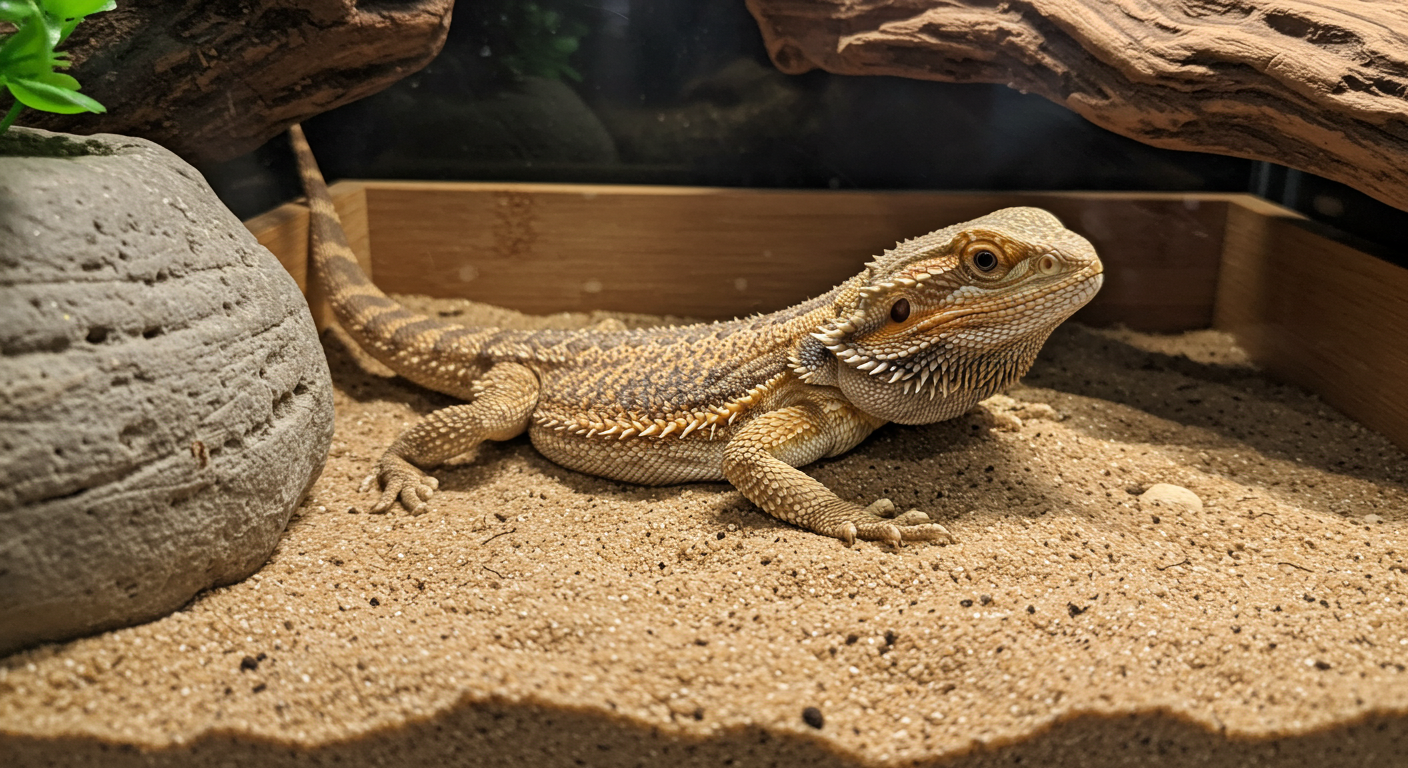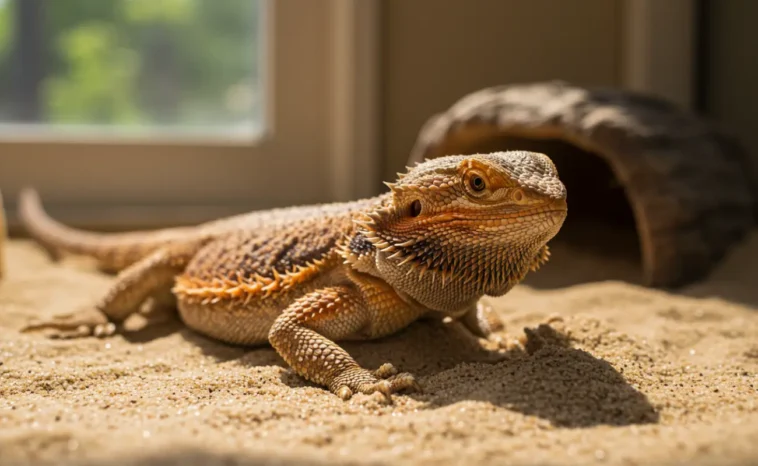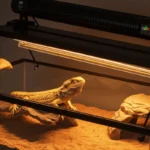If you’ve noticed your bearded dragon digging around its enclosure, you’re probably asking yourself, Why is My Bearded Dragon Digging? From scuffling in the sand to burrowing in a water dish, it’s natural to wonder, Why is My Bearded Dragon Digging? In this article, we’ll unravel the mysteries behind this instinctual behavior and share expert tips on how to address it.
Before we dive into the reasons, you might also find our in-depth review of the Zoo Med LF25 bearded dragon tank setup helpful for optimizing your habitat’s environment early on.
Overview
Digging is one of the most instinctual and natural behaviors for a bearded dragon. However, the reasons behind it can vary greatly depending on your dragon’s age, environment, and health. Whether your dragon is digging around in its water bowl, in the corner of its cage, or just making random holes in the substrate, this behavior can be a signal of various needs, from thermoregulation to nesting instincts.
In this article, we’ll break down the main reasons why your bearded dragon might be digging, discuss common scenarios, and offer some tips and solutions to ensure your dragon is comfortable and healthy.
Why Does My Bearded Dragon Keep Digging?
If your bearded dragon is constantly digging, it’s likely doing so for one of several reasons. Understanding the root cause can help you provide better care and create a more comfortable environment for your pet. Here are the most common reasons why a bearded dragon digs:
-
Lack of a Suitable Hide
Bearded dragons are naturally shy creatures that prefer to have hiding spots to feel secure. If your tank lacks proper caves or hides, your dragon might dig to create its own secure den. Providing hiding spaces like caves or logs can help reduce this behavior and create a more stress-free environment. -
Thermoregulation (Cooling Off)
Bearded dragons are ectothermic, meaning they rely on external heat sources to regulate their body temperature. If the basking area is too hot or there’s no cool retreat, your dragon may dig to find cooler substrate layers. It’s important to maintain a temperature gradient in the tank so your dragon can move between cooler and warmer areas as needed. -
Brumation Preparation
As winter approaches, bearded dragons may instinctively begin to dig in preparation for brumation, which is a form of reptilian hibernation. During this time, they become less active, may eat less, and dig to create burrows for a safe, cool resting spot. -
Egg-Laying in Females
If you have a female bearded dragon, digging may be a sign she is preparing to lay eggs. Gravid females will often dig to test potential nesting sites, excavate a shallow nest, and cover their eggs. -
Hunger / Foraging
Bearded dragons may also dig in search of food. In the wild, they often dig to uncover insects or roots, and this behavior can persist in captivity. If it’s been a while since feeding, your bearded dragon might be digging because it’s hungry.

What’s Behind My Bearded Dragon’s Nighttime Digging?
Nighttime digging is another behavior commonly observed in bearded dragons, and it can be linked to several causes:
-
Thermoregulation: If your bearded dragon is too hot in the basking area, it may dig at night to find a cooler spot in the substrate.
-
Brumation: As mentioned earlier, brumation is a natural, seasonal process that involves digging behavior. Your dragon may be preparing its sleeping area for a long rest during the cooler months.
If nighttime digging becomes excessive or is accompanied by other unusual behavior, it could be worth checking if the temperature gradient in the tank is appropriate for your dragon.
Why Is My Bearded Dragon Digging Around in the Water Bowl?
It’s not uncommon to see a bearded dragon digging around its water bowl. This can be puzzling at first, but it’s typically due to one of these reasons:
-
Cooling Off: Bearded dragons often dig around their water bowls to find a cooler substrate or to explore moisture, as they can’t always distinguish still water as easily as moving water.
-
Hydration Attempts: If your bearded dragon is dehydrated or struggling to drink from the bowl, it may dig in an effort to stir the water and make it more accessible.
-
Nesting Behavior (for Females): Gravid females might dig in the water bowl if they are preparing for egg-laying and feel the need to create a nesting area.
Make sure your water bowl is shallow and clean to prevent contamination and encourage drinking.
Why Does My Bearded Dragon Dig in Its Cage?
Digging within the tank can signal a few different issues, particularly if your dragon is constantly trying to escape or burrow into the substrate:
-
Burrowing Instincts: In the wild, bearded dragons dig to create comfortable resting areas. Providing plenty of hiding spots and soft substrate can alleviate this.
-
Stress or Discomfort: A new environment, improper lighting, or incorrect temperatures may cause your dragon to dig. Ensure the temperature and humidity levels in the tank are correct, and that your dragon has enough space to roam.
Bearded Dragon Digging but Not Eating: What’s Going On?
If your bearded dragon is digging but not eating, it may be linked to several potential issues:
-
Brumation: As winter approaches, bearded dragons may eat less and dig more as they prepare for brumation.
-
Temperature Issues: If your tank is too cold or there’s no proper basking area, your dragon might not feel motivated to eat.
-
Illness or Stress: If the environmental conditions are ideal, it might be worth checking for signs of illness or parasites. Stress from changes in routine or habitat can also suppress appetite.
Why Is My Bearded Dragon Always Digging in the Corner?
If your bearded dragon is consistently digging in the corner of the tank, it’s likely seeking a secure, enclosed space to rest. Corners are perceived as natural barriers, and some dragons prefer to dig in these areas to feel safe and secure. This behavior can be more pronounced in gravid females who are preparing for nesting.
Why Does My Bearded Dragon Dig in the Sand?
In the wild, bearded dragons often dig to find shelter from heat or to hunt for food. In captivity, digging in sand can replicate these behaviors. However, be mindful that sand can cause impaction if ingested, especially in younger dragons. It’s best to use non-particulate substrates like reptile carpet or ceramic tiles to prevent health issues.
Female Bearded Dragon Digging: What Does It Mean?
When a female bearded dragon starts digging, it is often a sign that she is preparing to lay eggs. This is a natural instinct and part of her reproductive cycle. Providing a dedicated lay box with moist sand or soil is essential to prevent egg-binding, a potentially dangerous condition where the female cannot lay her eggs.
The Benefits of a Digging Box for Your Bearded Dragon
Providing a digging box for your bearded dragon has multiple benefits:
-
Nesting for Gravid Females: Female dragons need a safe place to dig and lay their eggs, and a digging box provides this.
-
Stress Relief: Digging is a natural behavior that can help alleviate stress. A dedicated digging box gives your dragon a stress-free area to express this instinct.
-
Thermoregulation: If your dragon is digging due to temperature discomfort, a digging box with slightly moist substrate can offer a cool, comfortable environment.
Frequently Asked Questions (FAQ)
-
Why does my bearded dragon dig but not eat?
A lack of appetite combined with digging may signal brumation, stress, or improper tank conditions. Check the temperature, humidity, and overall care routine. -
Is it normal for my bearded dragon to dig at night?
Yes, nighttime digging is often linked to thermoregulation or brumation behaviors. Ensure your tank’s temperature range is appropriate. -
Why does my bearded dragon dig in its water bowl?
Digging in the water bowl can be a sign your dragon is either seeking hydration or cooling off. Ensure the bowl is shallow and clean. -
How do I stop my bearded dragon from digging in the corner?
Corners are often preferred for security. Ensure your dragon has plenty of hiding spots and check for stress or temperature issues. -
Why does my female bearded dragon dig?
Female dragons often dig when they are preparing to lay eggs. Provide a digging box filled with moist substrate to support this natural behavior.

Conclusion and Call-to-Action
Understanding why your bearded dragon digs is essential for providing the best care possible. Whether it’s for temperature regulation, nesting, or simply comfort, digging is a natural and instinctive behavior. By ensuring that your tank is properly equipped with hiding spots, the right temperature gradients, and a dedicated digging box, you can help your dragon thrive in captivity. If you’re unsure about any specific behavior or notice other concerning signs, consult a reptile veterinarian.
Have questions or thoughts about your bearded dragon’s behavior? Feel free to share them in the comments or explore other articles on our blog for more helpful tips.





